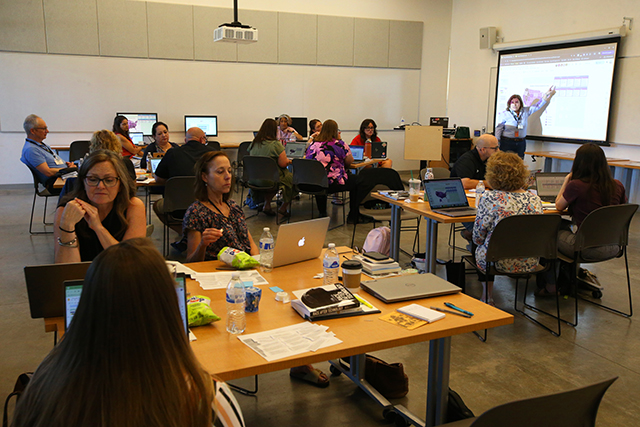Oregon math, reading achievement among the nation’s worst, new scores show
Published 8:33 am Wednesday, January 29, 2025

- Students walk through a hallway at Sisters Elementary in Sisters in this file photo.
In the latest confirmation that extended pandemic-era school closures took a huge toll on a generation of young Oregonians, new federal test results show the state’s middle and elementary students still lag far behind in reading and math.
Pre-pandemic, Oregon students regularly bested those in other states or at least ranked near national averages on the National Assessment of Education Progress, the only standardized achievement test given to a representative sample of students in all states.
Trending
Post-pandemic data, including the 2024 scores released late Tuesday, tells a very different story.
Oregon fourth graders who were tested in early 2024 ranked second worst in the country in math and tied with 10 other states for third worst in reading. Eighth graders tested in the same time period, who are now halfway through their first year in high school, performed far below the national average in math but close to the middle of the pack in reading.
After COVID shuttered schools nationwide in March 2020, Oregon’s mostly remained closed until spring 2021, longer than almost anywhere else in the country. The Oregon fourth graders who took the federal reading and math tests last year had the end of their kindergarten year clipped off, then spent most of first grade learning online, with sparse hours of virtual instruction.
But students have been back to in-person learning since fall 2021. And Oregon’s 197 school districts shared more than a billion dollars in federal pandemic aid to help their students readjust emotionally and recover academically.
That money is now gone, however, and the state’s children haven’t caught up. Struggling fourth grade readers were further behind in 2024 than previous fourth graders, now in seventh grade, were in 2022, the federal tests found.
Those tests, dubbed “the Nation’s Report Card” because they allow state-by-state comparisons over time in a way that other testing data does not, offer a window into classrooms but not a complete picture of student learning. National educational experts said Tuesday they hope the results can highlight successes that can be replicated elsewhere and spotlight areas where more focus is needed.
Trending
The results show that Oregon’s current fifth graders posted bottom-of-the-barrel math scores that were measurably worse than those in 45 other states, better only than New Mexico’s and statistically unchanged from the last time their age group was tested, in spring of 2022.
Even more worrisome: A full third of Oregon’s then-fourth graders who took the federal test scored “below basic” on the math section, meaning that they could not complete foundational tasks like identifying whole numbers on a number line or locate the lines of symmetry in shapes like triangles and rhombuses. Nationwide, a quarter of students scored “below basic.”
Reading test results were even more alarming for the fourth graders.
Forty-eight percent scored “below basic” in reading, meaning that they could not yet determine the sequence of events described in a passage, nor could they fully determine the meaning of a familiar word using context clues. The national average was 41%.
The fourth grade reading scores were below those in 38 other states, similar to those in 11 others and better only than New Mexico and Alaska. Their average scores were below where they were in 2022.
In a call with reporters on Tuesday, Peggy Carr, commissioner of the National Center for Education Statistics, made it clear that Oregon was not alone. What recovery is evident is being driven by higher-performing students, she said, even as huge swaths of their classmates seem stuck, despite a nationwide push to expand small group tutoring and revamp the way younger students are taught to read.
“The Nation’s Report Card is out and the news is not good,” Carr said. “Lower performing students are struggling, especially in reading. In eighth grade math, the gap (between the highest and the lowest performing students) is the widest it has ever been.”
Progress is not impossible, Carr said. Some urban school districts, including Atlanta, bucked the trends. And in Louisiana, fourth grade students across all proficiency levels posted better results than before the pandemic; the same is true in Alabama in math.
Oregon’s eighth grade trend lines in reading were also worrisome. Some 45% of the state’s test-takers scored below “basic,”compared to 41% nationwide. That means that they struggled with basic literary skills, like identifying the main idea or character traits from an excerpt. Twenty-five years ago, 30% of the state’s eighth graders tested at below basic levels on the federal tests.
Only New Mexico, Alabama, West Virginia and Delaware posted eighth grade reading scores significantly below Oregon’s.
Across both grade levels, one of the broadest predictors of how an Oregon student might score is their family income level, regardless of their demographic background. Students from low-income families had average scores between 25 and 31 points lower than students whose families were deemed financially stable. Thirty points represents roughly the difference between scoring “below basic” and “basic” or scoring “basic” versus “proficient” for one’s grade level.
The federal tests do not show results for Black and Indigenous students in Oregon, because too few of them are tested for conclusions to be statistically accurate. But Hispanic students across the two grade levels scored between 21 and 31 points lower than their white counterparts.
Charlene Williams, Oregon’s state schools chief, acknowledged the disappointing results Tuesday and said the state will try to address the disparities by “doubling down on efforts that we know from research help move the needle.” She cited spending on programs designed to keep ninth graders on track for graduation, summer school and curriculum updates as examples.








